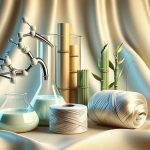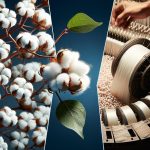I've been digging into why we should skip rayon, and honestly, the reasons pile up fast. It's not just about the nasty chemicals used in making it, which by the way, are pretty harsh on both workers and the environment. There's also this whole thing about how wearing it might not be as benign as we've been led to believe, with skin irritations and other health snags popping up. And don't get me started on the environmental toll. But here's where it gets interesting – there are alternatives that don't force us to choose between looking good and feeling good about our choices. Stick around, and let's unpack why making a switch might just be a game-changer.
Table of Contents
Key Takeaways
- Rayon production involves harmful chemicals, posing serious health risks to workers and contaminating ecosystems.
- Exposure to rayon can cause skin irritations, allergies, and other health hazards like nausea and headaches.
- The environmental impact of rayon includes deforestation, disruption of ecosystems, and significant contribution to global pollution.
- Fast fashion's use of rayon prioritizes cheap, quick production over environmental and social sustainability.
- Alternatives like organic cotton, hemp, and Tencel offer more environmentally friendly and sustainable options compared to rayon.
The Toxic Production Process
While rayon's sleek look may appeal to many, it's crucial to know that its production process is anything but clean, exposing workers to harmful chemicals and wreaking havoc on our environment.
The journey from plant-based cellulose to that shiny fabric involves a cocktail of dangerous substances, including carbon disulfide, which poses serious health risks to those in the manufacturing line. Workers are at the frontline, facing toxic exposure that can lead to long-term health issues. It's not just an occupational hazard; it's a ticking time bomb for their wellbeing.
Beyond the immediate vicinity of factories, the environmental toll is equally alarming. The disposal of chemical waste into our water sources doesn't just vanish; it contaminates ecosystems, harming aquatic life and ultimately circling back to us. Rayon production, with its heavy chemical and energy use, contributes significantly to environmental pollution. It's a cycle of damage that starts with the demand for this fabric and ends with lasting impacts on both human health and our planet.
Health Hazards of Rayon
Rayon's got a dark side, posing serious health risks like nausea and headaches for folks who wear it or live near its production sites. It's not just the discomfort of wearing something that feels off; it's about the toxic substances that sneak their way into our lives.
- Health Issues Galore: We're talking nausea, headaches, and even insomnia. The chemicals used in rayon's production don't just vanish; they linger, affecting those who wear rayon clothes or are in proximity to manufacturing sites.
- Skin and Breathing Troubles: Imagine wearing a shirt that not only irritates your skin but also makes it hard to breathe. That's rayon for you. The absorbed toxins can cause skin irritations and breathing difficulties, turning a simple outfit into a health hazard.
- Community Poisoning: It's bigger than just personal health; it's about community well-being. The harmful chemicals involved in making rayon contribute to environmental pollution and, ultimately, community poisoning. Dangerous doesn't even start to cover it.
Environmental Impact
Beyond its sleek appearance, rayon's production has a hefty environmental toll, doubling in the last three decades and contributing significantly to global pollution. Let's dive into why this is a big deal. First off, the environmental impact of rayon production isn't something to brush off. We're talking about processes so toxic they're not just harmful to our planet but also to the workers involved. It's a double whammy of pollution and health risks that's persisted into modern production methods.
The thing is, as demand has grown, so has the strain on our environment. Deforestation is a huge part of the problem. To produce rayon, vast areas of forest are cleared, messing with ecosystems and biodiversity. It's a classic case of not seeing the forest for the trees, quite literally.
Efforts to reduce these environmental impacts are crucial. We need to rethink how rayon is produced and tackle those harmful processes head-on. It's about finding a balance that keeps our wardrobes fresh without tipping the environmental scales too far. So, as we weave our way through the fabric of modern fashion, let's not forget the footprint it leaves behind.
Alternatives to Rayon
So, we've talked a lot about why rayon mightn't be the best pick, right?
Now, I'm gonna chat about some cool alternatives, like natural fibers and some synthetic options that are way kinder to our planet.
Things like hemp, organic cotton, and Tencel are on my list, and they're not just good for the environment, but they're also pretty awesome for us to wear.
Natural Fiber Options
I often look for alternatives like organic cotton and hemp to dodge the downsides of rayon. Here's why:
- Biodegradability: Organic cotton, hemp, and linen break down naturally, leaving a smaller environmental footprint than rayon. These materials don't just sit in landfills for centuries.
- Ethical Production: Choosing fabrics like Tencel and organic cotton supports more sustainable farming and manufacturing practices. It's about wearing clothes that align with my values of eco-conscious fashion.
- Environmental Friendliness: Hemp, Pinatex, and Tencel have a lower ecological impact, from water usage to pesticide need, making them top picks for anyone aiming to reduce their carbon footprint.
Opting for these sustainable fabrics not only benefits our planet but also pushes the fashion industry towards more ethical and environmental practices.
Synthetic Eco-Friendly Choices
While we've explored natural fibers as alternatives to rayon, let's not overlook synthetic eco-friendly options that offer both sustainability and innovation.
Here's a quick look at some standout choices:
| Material | Source | Key Benefits |
|---|---|---|
| Tencel | Sustainably sourced wood pulp | Closed-loop production, soft, durable |
| Hemp | Hemp plant | Minimal environmental impact, breathable |
| Organic Cotton | Ethically farmed cotton | Free from harmful chemicals, sustainable |
| Pinatex | Pineapple leaf fibers | Reduces waste, ethical production |
These materials aren't just about looking good; they're about doing good, too. With Tencel's closed-loop production and hemp's minimal impact, you're not just choosing eco-friendly options; you're choosing a future where fashion and sustainability go hand in hand.
Skin Irritations and Allergies
Rayon's got a shady side; it's the chemicals used in making it that can mess with your skin, causing all sorts of irritation and allergic reactions. Despite its smooth feel, diving deeper into the production process of rayon fabric reveals why it mightn't be the best choice for everyone, especially for those with sensitive skin. Here's the lowdown:
- Chemicals Galore: The production of rayon involves a cocktail of toxic substances. These chemicals don't just disappear after the fabric is made; they can linger, leading to skin reactions like rashes and itching.
- Sensitive Skin's Nemesis: If you've got sensitive skin, rayon might as well be your kryptonite. The absorbed toxins from rayon fibers are notorious for triggering allergic reactions, leaving you uncomfortable and seeking relief.
- Dermatitis Central: Contact dermatitis isn't just an annoying term; it's a real risk with rayon. Wearing clothes made from this fabric can lead to this condition, characterized by red, itchy, and irritated skin.
The Role of Fast Fashion
Fast fashion's a major player in pushing rayon into our closets, prioritizing quick, cheap production over our skin and the planet's health. This industry's all about making us think we need the latest trends, only to ditch them for the next big thing, creating a cycle of waste that's hard to ignore. They're making a killing, but at what cost?
The truth is, fast fashion doesn't care much for sustainability or ethical practices. It's a world where profit trumps the well-being of workers who face grim conditions and exploitation. And let's not even get started on the environmental impact. We're talking serious pollution, from the dyes and treatments used on fabrics like rayon, to the sheer volume of resources guzzled up and greenhouse gases pumped out.
It's a mess, frankly. As someone who's diving deep into why we should steer clear of rayon, it's clear that fast fashion's role is undeniable. The industry's disregard for workers' rights and the environmental damage it causes is alarming. It's high time we demanded more accountability and pushed for a shift towards more sustainable, ethical fashion choices.
The Cost of Cheap Clothing
The hunt for bargain deals often blinds us to the true cost of cheap clothing, including the hazardous production of materials like rayon. We're lured in by low prices, not seeing the hidden expenses to health, environment, and society. The production of rayon, a popular but problematic fabric, brings to light the darker side of fashion's affordability.
Here's what you need to know about the impacts of rayon:
- Health Hazards: The toxic chemicals used in rayon's production can cause serious health issues like nausea, headaches, and insomnia for those wearing it and even more severe conditions for factory workers handling these substances daily.
- Environmental Damage: The disposal of rayon's harmful chemicals contributes significantly to community poisoning, deforestation, and pollution of ecosystems. It's a cycle of destruction, from tree to toxic waste.
- Community and Worker Safety: Beyond environmental damage, the communities around production facilities and the workers within them face daily risks from exposure to these toxic substances. The process puts everyone at risk, from the local to the global community.
Understanding the true cost behind cheap rayon clothing highlights the need for more responsible consumption choices. It's not just about saving a few dollars; it's about protecting our health, our planet, and our fellow humans.
Moving Towards Sustainability
Shifting our focus to sustainability, we've gotta tackle the tough issues surrounding rayon's production head-on. With its environmental impact doubling in the last 30 years and making up a significant chunk of the global fiber market, we can't ignore the toxic processes that not only harm our planet but also pose serious health risks to workers. It's clear that the path forward requires ditching these outdated methods for more sustainable alternatives.
The dark history of rayon, including its links to Nazi forced labor, raises major ethical concerns that we can't just sweep under the rug. It's not just about the pollution or the health risks anymore; it's about acknowledging this past and ensuring our choices today don't echo those mistakes.
Moreover, the threat of deforestation to feed rayon production is real. We need to champion environmentally friendly practices that protect our forests, not destroy them. Moving towards sustainability means rethinking how we produce and consume rayon, pushing for innovations that minimize its environmental footprint. It's a hefty task, but one we've gotta embrace for the sake of our planet and future generations.
Frequently Asked Questions
Why Is Rayon Not Used Anymore?
I've learned that rayon's not used much anymore because its production involves harmful chemicals. These bad practices lead to health issues and environmental damage, making folks rethink wearing or using products made from it.
Should I Avoid Rayon Clothes?
I've been thinking about whether I should avoid rayon clothes due to their environmental and health impacts. Given the harmful production process and risks, I'm leaning towards cutting them out of my wardrobe.
What Is the Problem With Rayon Fabric?
I've learned that the main issue with rayon fabric is its production process. It's harmful to both health and the environment, releasing toxic substances and contributing to pollution and deforestation. It's definitely concerning.
What Are the Disadvantages of Rayon?
I've learned rayon's disadvantages include health risks like nausea, environmental harm through pollution and deforestation, and danger to workers from toxic chemicals. It's clear the fabric's impact isn't just on fashion but on our planet too.
- Tetron Fabric for Marine Applications: Durability and Use Cases - June 18, 2025
- Tetron Fabric for Outdoor Furniture: Weather Resistance and Care - June 18, 2025
- Tetron Fabric for Wall Coverings: Style and Application Tips - June 18, 2025






